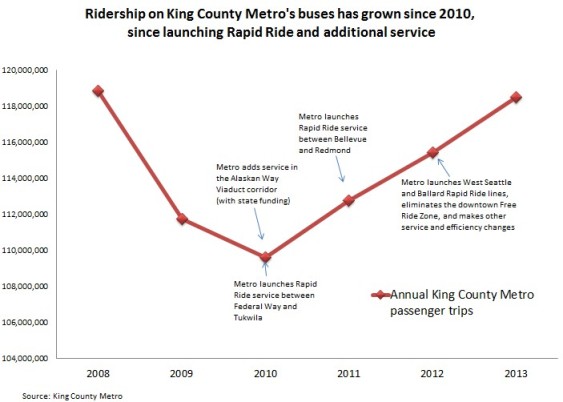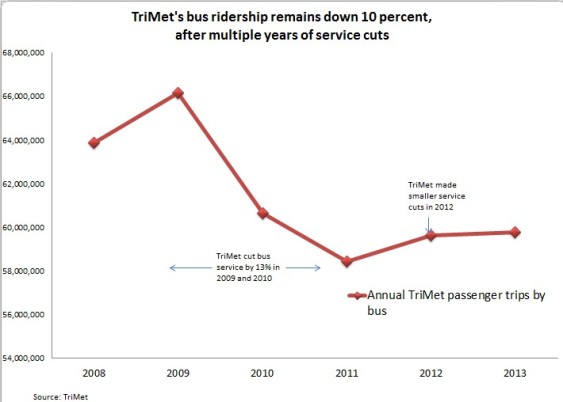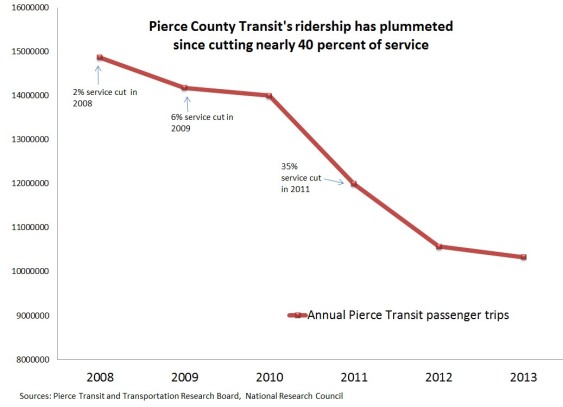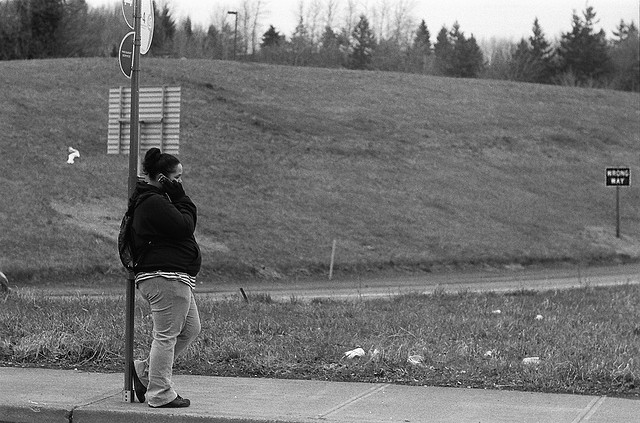Seattle recently got accolades for being one of the US cities with significant growth in transit ridership. This mirrors a national trend in which more people rode buses, trains, streetcars and subways last year than at any time since 1956.
A good part of that bump came from Sound Transit. But King County Metro’s bus ridership also grew by 3 percent last year, and it has nearly reached the record levels the agency hit in 2008 before the latest recession drove ridership numbers down.
Yet several Cascadian neighbors, namely Portland and Tacoma, haven’t had that same experience. Portland’s bus ridership remains about 10 percent lower than its pre-recession peak, and Pierce Transit’s ridership has dropped by more than 30 percent.
What’s the difference? Bus cuts.
King County voters will decide on April 22 whether to approve Proposition 1, which would make needed investments to fix local roads and prevent an up to 17 percent cut in bus service. We can see from other places that significantly cutting transit service is one of the quickest ways to turn a region with healthy growth in transit ridership—which takes cars off our roads and allows the region to grow without adding to our pollution and traffic and health burdens—into a region where significant numbers of riders simply give up on transit and get back in their cars.
But first, let’s look at what King County’s experience has been over the last five years.

Ridership fell as the economy went into the tank but began rising again in 2010, which is also around the time that King County Metro was able to add more bus service in the Alaskan Way Viaduct corridor, thanks to temporary state funding designed to offset construction congestion. And guess what? Traffic in that corridor plummeted as people parked their cars and realized they didn’t need them to get around.
That’s also when Metro began operating Rapid Ride service in South King County and the Eastside, with later expansions in the West Seattle, Ballard, and Aurora Avenue corridors. Those investments were made possible by the Transit Now initiative voters passed in 2006, along with federal and state grants. Seattle’s Bridging the Gap initiative has paid for signal and road improvements that allow buses to travel faster and to avoid sitting in traffic.
Those improvements have been crucial, because when people are standing on a bus and noticing that they’re whizzing by a long line of cars stuck in traffic, that’s precisely when they become loyal and grateful customers. The net effect of those investments—even with cost-cutting measures in 2012 that eliminated the Ride Free Zone and some less efficient service—is that more people are finding Metro a convenient and viable alternative to driving than almost ever before.
In Portland, however, it’s a different story. From 2009 to 2012, TriMet had a series of significant bus service cuts. The upshot was that buses came less frequently, connections were easier to miss, and everyone from single moms to downtown employees to elderly riders found themselves waiting at bus stops. Commutes became longer and less convenient, while some night shift workers at hotels or restaurants found they couldn’t get a bus home at all.
So bus ridership took a nosedive and pretty much stayed there. And a city that was once hailed as having one of the best public transportation systems has missed out on the transit ridership boom that the rest of the country has enjoyed.

For an even more dramatic example, just look at Pierce Transit in the Tacoma area. Pierce County voters have rejected two recent ballot measures to raise new revenue. The agency has cut service three times since 2008, including a whopping 35 percent cut in 2011. And here’s what happened to ridership:

In fact, Pierce Transit was used as a case study in this National Research Council 2012 report on the impact of transit cuts nationwide. Among other things, the report found that:
- lower-income service workers had to start taking expensive taxis home because of reduced evening and weekend schedules
- people who work on the Joint Base Lewis-McChord lost internal shuttle service, making it very difficult to access the region’s largest employer using public transportation
- the school system had to spend $100,000 on new school buses because students no longer had workable transit options
- parents had a harder time getting to their children’s schools for meetings
- community events like the Puyallup Fair had to start hiring private operators to provide transportation services
- former riders who had access to cars started using them again, even as gas prices increased
King County Metro is in the same boat as Pierce Transit, suffering from the same massive shortfalls that resulted from a downturn in sales tax revenue after the economy slowed. Until now, the agency has been able to avoid major service cuts by slashing internal costs, looking for efficiencies, spending down reserves, raising fares, and relying on band-aid funding solutions that Olympia was willing to approve.
But there’s nothing left to cut except service, and in a major way. That’s why county officials have formed a local Transportation Benefit District and are asking voters to approve a tenth-of-a-penny sales tax increase and $60 annual vehicle tab fee. If it fails, more of the county’s roads and bridges will fall into disrepair and the agency will proceed with cutting 600,000 hours of bus service.
This would be an almost unfathomable setback, especially now. Previous investments in transit service are paying off in King County, and more riders are finding bus service to be convenient and preferable to driving alone and sitting stuck in traffic. We need only look to Portland and Tacoma’s bus systems to find out how quickly that trend line can change.


Comments are closed.